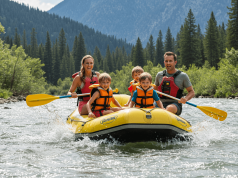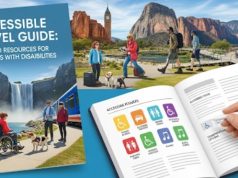Adventure doesn’t have to wait until the kids grow up. Family adventure travel opens doors to experiences that strengthen bonds, build confidence, and create stories you’ll share for years to come. From toddlers taking their first nature hike to teenagers conquering their fear of heights on a zip line, every family member can find their comfort zone while stepping just outside it.
The best part? Adventure travel with kids teaches resilience, problem-solving, and cultural awareness in ways no classroom can match. Your children will learn to adapt to new environments, try unfamiliar foods, and connect with people from different backgrounds. These experiences shape young minds and create confident, curious adults.
Planning family adventures requires more thought than solo trips, but the rewards multiply exponentially when you see your child’s face light up at their first glimpse of a snow-capped mountain or their proud smile after completing a challenging trail.
Why Adventure Travel Benefits the Whole Family

Adventure travel pushes families out of their comfort zones in the best possible way. Children develop physical confidence as they navigate new terrains, while parents rediscover their sense of wonder through their kids’ eyes. These shared challenges create unbreakable bonds and mutual respect between family members.
Research shows that families who travel together report stronger relationships and better communication. Adventure activities specifically build trust as family members rely on each other for support and encouragement. Whether you’re spotting wildlife on a safari or navigating a new city together, these experiences create a team mentality that carries over into daily life.
Adventure travel also provides natural learning opportunities. Geography becomes real when your child stands at the base of a volcano. History comes alive when they explore ancient ruins. Science concepts click when they observe ecosystems firsthand.
Choosing Age-Appropriate Adventures
The key to successful family adventure travel lies in matching activities to your youngest traveler’s abilities while keeping older kids engaged. This doesn’t mean avoiding exciting destinations—it means adapting your approach.
Adventures for Toddlers and Preschoolers (Ages 2-5)
Young children thrive on sensory experiences and short bursts of activity. Beach destinations offer endless entertainment through sand castle building, tide pool exploration, and gentle wave play. National parks with easy walking trails provide opportunities to spot wildlife and collect interesting rocks or leaves.
Consider destinations with interactive elements like children’s museums, aquariums, or farms where kids can touch and feed animals. Short train rides, cable cars, or boat trips add excitement without requiring physical endurance.
Activities for Elementary Age (Ages 6-11)
This age group has increased stamina and coordination, opening up more adventurous possibilities. Moderate hiking trails, beginner rock climbing walls, and kayaking in calm waters become achievable goals. Theme parks with adventure elements, zip lining courses designed for children, and snorkeling in shallow, clear water provide thrills without overwhelming young adventurers.
Cultural adventures work well, too. Cooking classes, traditional craft workshops, and guided tours with kid-friendly guides help children connect with local traditions.
Challenges for Teens (Ages 12+)
Teenagers can handle nearly adult-level adventures with proper supervision and preparation. Multi-day hiking trips, serious rock climbing, white water rafting, and scuba diving certification courses appeal to their growing independence and physical capabilities.
Adventure travel during these years builds confidence and creates shared accomplishments between parents and teens. The mutual respect earned through conquering challenges together often improves family dynamics during these potentially difficult years.
Planning Your Family Adventure
Successful family adventure travel starts with an honest assessment of your family’s interests, fitness levels, and comfort zones. Include everyone in the planning process to ensure buy-in from all family members.
Research and Preparation
Start planning at least three to six months ahead for international destinations or popular adventure spots. Research visa requirements, vaccination needs, and any special gear required for your chosen activities. Read reviews from other families who have taken similar trips, focusing on practical details like accommodation quality and activity difficulty levels.
Create packing lists specific to each family member’s needs and age. Consider renting gear at your destination rather than traveling with bulky equipment, especially for activities you might only try once.
Safety Considerations
Adventure travel with children requires extra safety measures. Research medical facilities at your destination and ensure your travel insurance covers adventure activities. Pack a comprehensive first aid kit and ensure all family members know basic safety protocols.
Choose reputable tour operators with experience guiding families. Look for certifications, read recent reviews, and don’t hesitate to ask about their safety records and emergency procedures.
Budget-Friendly Adventure Options
Adventure travel doesn’t require breaking the bank. National and state parks offer incredible experiences at fraction of resort costs. Camping combines outdoor adventure with significant savings, while vacation rentals provide flexibility for families with varying schedules and dietary needs.
Consider shoulder season travel when destinations offer lower prices but still favorable weather. Many adventure activities cost less when booked directly with local operators rather than through resorts or cruise lines.
Top Family Adventure Destinations
Costa Rica
Costa Rica delivers incredible biodiversity, stable infrastructure, and adventure activities suitable for all ages. Zip lining through cloud forests, spotting sloths and colorful birds, and relaxing on pristine beaches create the perfect adventure-relaxation balance.
The country’s commitment to conservation education makes it ideal for teaching children about environmental responsibility. Many lodges offer guided nature walks specifically designed for families.
New Zealand
New Zealand’s stunning landscapes provide backdrops for adventures ranging from gentle to extreme. Younger children enjoy gondola rides and easy hiking trails, while older kids can try bungy jumping, white water rafting, and glacier hiking.
The country’s excellent infrastructure and English-speaking population make logistics easier for families new to international adventure travel.
Utah’s National Parks
Utah’s “Big Five” national parks offer something for every family member. Easy walks to stunning viewpoints accommodate young children, while challenging slot canyon hikes and rock scrambling adventures thrill teenagers.
The American Southwest’s clear skies provide incredible stargazing opportunities, while Native American cultural sites add educational value to outdoor adventures.
Iceland
Iceland combines dramatic landscapes with family-friendly infrastructure. Geysers, waterfalls, and unique geological formations captivate children, while activities like horse riding, whale watching, and soaking in natural hot springs provide comfortable adventure levels.
The country’s emphasis on renewable energy and environmental protection offers valuable learning opportunities about sustainability.
Making the Most of Your Family Adventure
Involve Everyone in Planning
Give each family member responsibility for researching one aspect of the trip. Children might choose restaurants, research local animals, or learn basic phrases in the local language. This involvement creates excitement and investment in the trip’s success.
Document the Journey

Encourage children to keep travel journals, collect postcards, or create photo albums. These tangible memories become treasured keepsakes and conversation starters for years afterward.
Embrace Flexibility
Adventure travel with children requires flexibility. Weather changes, tired kids, or unexpected opportunities might alter your plans. Build buffer time into your itinerary and approach changes as part of the adventure rather than frustrating setbacks.
Focus on Experience Over Perfection
The best family adventures rarely go exactly as planned, and that’s perfectly fine. Missed connections become funny stories, unexpected detours lead to discoveries, and challenging moments build character. Focus on experiencing new things together rather than executing a perfect itinerary.
Building Lifelong Adventurers
Family adventure travel creates more than memories—it shapes perspectives and builds confidence that lasts a lifetime. Children who experience adventure with their families often become adults who seek out new experiences, embrace challenges, and feel comfortable in unfamiliar situations.
These trips also strengthen family bonds in ways that regular vacations cannot. Shared challenges, mutual support, and collective achievements create deeper connections between family members. The trust built during adventure activities carries over into daily life, improving communication and understanding.
Start planning your family’s next adventure today. Whether you choose a weekend camping trip to a nearby state park or an international expedition, the memories and bonds you’ll create are worth every effort. Your children will thank you not just for the experiences, but for showing them that adventure and family time can beautifully coexist.







